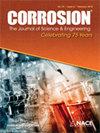Galvanic Corrosion of Tinned Copper Coupled with Aluminium Alloy in Electric Vehicle
IF 1.1
4区 材料科学
Q4 MATERIALS SCIENCE, MULTIDISCIPLINARY
引用次数: 0
Abstract
In this study, the galvanic corrosion behavior of a tinned Cu terminal coupled with an Al–Mg–Si alloy was analyzed. When the Al alloy and tinned Cu were electrically connected and exposed to an electrolyte, tri–metallic galvanic corrosion occurred between the Al alloy, the Sn plating, and the Cu base metal. Results from Potentiodynamic and zero resistance ammeter tests indicate that the total galvanic corrosion rate increases as the area ratio of Sn plating to the Cu base metal decreases. Furthermore, the Sn, which has an intermediate potential, may function as either an anode or a cathode. While most of the Sn plating was protected by the Al alloy, corrosion of the Sn plating was observed at the boundary between the Sn plating and the Cu base metal. Thus, the exposed Cu area and galvanic corrosion of the Al-tinned Cu couple increase over time. Consequently, to prevent failure due to corrosion at the connection of the Al body and the tinned Cu terminal, exposed Cu area and damage of the Sn plating of tinned Cu terminal should be minimized.电动汽车中镀锡铜与铝合金的电化学腐蚀
本研究分析了镀锡铜端子与铝镁硅合金的电化学腐蚀行为。当铝合金和镀锡铜电连接并暴露在电解液中时,铝合金、镀锡层和铜基体金属之间发生了三金属电化学腐蚀。电位计和零电阻电流表测试的结果表明,随着镀锡层与铜基体金属的面积比减小,总的电化学腐蚀率也随之增大。此外,具有中间电位的锡既可作为阳极,也可作为阴极。虽然大部分镀锡层都受到铝合金的保护,但在镀锡层和铜基底金属的交界处还是观察到了镀锡层的腐蚀。因此,随着时间的推移,暴露的铜面积和铝锡铜耦合的电化学腐蚀都会增加。因此,为防止铝本体和镀锡铜端子连接处因腐蚀而失效,应尽量减少铜的暴露面积和镀锡铜端子镀锡层的损坏。
本文章由计算机程序翻译,如有差异,请以英文原文为准。
求助全文
约1分钟内获得全文
求助全文
来源期刊

Corrosion
MATERIALS SCIENCE, MULTIDISCIPLINARY-METALLURGY & METALLURGICAL ENGINEERING
CiteScore
2.80
自引率
12.50%
发文量
97
审稿时长
3 months
期刊介绍:
CORROSION is the premier research journal featuring peer-reviewed technical articles from the world’s top researchers and provides a permanent record of progress in the science and technology of corrosion prevention and control. The scope of the journal includes the latest developments in areas of corrosion metallurgy, mechanisms, predictors, cracking (sulfide stress, stress corrosion, hydrogen-induced), passivation, and CO2 corrosion.
70+ years and over 7,100 peer-reviewed articles with advances in corrosion science and engineering have been published in CORROSION. The journal publishes seven article types – original articles, invited critical reviews, technical notes, corrosion communications fast-tracked for rapid publication, special research topic issues, research letters of yearly annual conference student poster sessions, and scientific investigations of field corrosion processes. CORROSION, the Journal of Science and Engineering, serves as an important communication platform for academics, researchers, technical libraries, and universities.
Articles considered for CORROSION should have significant permanent value and should accomplish at least one of the following objectives:
• Contribute awareness of corrosion phenomena,
• Advance understanding of fundamental process, and/or
• Further the knowledge of techniques and practices used to reduce corrosion.
 求助内容:
求助内容: 应助结果提醒方式:
应助结果提醒方式:


